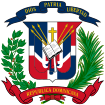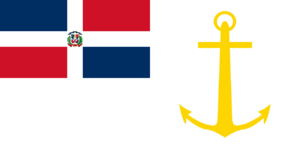President of the Dominican Republic facts for kids
Quick facts for kids President of the Dominican Republic |
|
|---|---|

Presidential seal
|
|

Coat of arms of the Dominican Republic
|
|
| Style | Your Excellency, Mr. President His Excellency |
| Residence | National Palace, Distrito Nacional, Santo Domingo |
| Appointer | Universal suffrage election |
| Term length | Four years, renewable once (consecutively) |
| Inaugural holder | Pedro Santana |
| Formation | 14 November 1844 |
| Deputy | Vice President of the Dominican Republic |
| Salary | up to RD$450,000/US$ 8,213 monthly |
The president of the Dominican Republic (Spanish: Presidente de la República Dominicana) is the top leader of the country. This person is both the head of state and the head of government. This means they represent the country and also lead its daily operations. The idea of having a president started in 1844, after the Dominican Republic became independent.
When someone is president, they are called Your Excellency, Mr. President. Their main home for work is the National Palace in Santo Domingo. The president's job is to make sure the laws of the Dominican Republic are followed. They are also the commander-in-chief of the Armed Forces and the National Police. This means they are in charge of the country's military and police forces.
The president can choose ministers to help run the government. They also make sure the country's money is collected and spent wisely. The president leads the country's relationships with other nations. They can appoint diplomats to represent the Dominican Republic around the world.
The president is chosen by the people in an election every four years. This is called universal suffrage. Since 2015, a person can only be elected president twice in a row. If a president dies, is removed, or resigns, the vice president of the Dominican Republic takes over. If both are unavailable, the government will find a way to keep things running.
So far, 54 people have been president. The first president was Pedro Santana, who started his term on November 14, 1844. The current president is Luis Abinader from the Modern Revolutionary Party. He won the 2020 Dominican Republic general election and took office on August 16, 2020. He was re-elected in 2024 for a second term. In recent years, the Dominican president has become more involved in world affairs. They help strengthen ties with other countries and even help solve conflicts.
Contents
How the Presidency Started
The idea of a president in the Dominican Republic began during the Dominican War of Independence. At that time, a group called the Central Government Junta (JCG) was the first government.
Their main job was to lead the war against the Haitian invasion. They also had to set up the new country's government. This included collecting taxes and telling other countries that the Dominican Republic was now independent. At first, the JCG even kept some Haitian laws in place. This was to make sure things like courts and customs continued to work. The JCG led the country for about eight months.
In July 1844, General Pedro Santana arrived in Santo Domingo with his army. He was then named President of the Central Government Junta. A month later, Santana sent the country's Founding Fathers away. On November 14, 1844, he officially became the first constitutional president of the Dominican Republic.
President's Role in the Constitution
The Constitution of the Dominican Republic explains the president's job. It also lists what they must do and what they are allowed to do. The constitution was last updated in 2015.
A president can serve for two terms, each lasting four years. After serving two terms, they cannot run for president again. The new president takes office every four years on August 16. This day is a national holiday called the Restoration of the Republic. Before 2015, a president could only serve one term in a row. However, they could run again after someone else had been president for at least one term.
Powers of the President
The president of the Dominican Republic has many important powers and duties. These are listed in the country's constitution.
As the head of state, the president:
- Leads important national ceremonies.
- Makes sure laws passed by the National Congress are put into action. They can also issue decrees and instructions.
- Can hire or fire members of the military and police.
- Signs international agreements with other countries. These agreements must be approved by the National Congress.
- Is in charge of the armed forces and national police. They can use them for public service.
- Takes steps to protect the country if there is an attack from another nation. They must tell the National Congress about these steps.
- Can declare a state of emergency if the National Congress is not meeting. This is done to protect the country.
- Can take steps to keep public order and safety. This is done if things are disrupting the country or its economy.
- Manages everything related to national security, including air, sea, and land areas.
- Can grant pardons on February 27, August 16, and December 23 each year.
- Can arrest or send away foreigners whose actions might harm public safety.
- Can stop foreigners from entering the country if it is for the public good.
As the head of government, the president:
- Appoints ministers, deputy ministers, and other public officials. They can also accept their resignations or remove them.
- Appoints leaders of government agencies and organizations. They can also accept their resignations or remove them.
- Can change their official residence if needed.
- Signs contracts. Some contracts, like those involving national money or selling state property, need approval from the National Congress.
- Makes sure national income is collected well and spent wisely.
- Gives a report to the National Congress every year on February 27. This report covers how the government was run the previous year.
- Submits the national budget plan to the National Congress by October 1 each year.
As both head of state and government, the president:
- Appoints ambassadors to other countries and leaders of international organizations. This needs approval from the Senate. They also appoint other diplomats.
- Leads diplomatic talks and welcomes leaders from other countries.
- Decides if Dominican citizens can work for foreign governments or international groups in the Dominican Republic. They also decide if citizens can accept awards from foreign governments.
- Approves or rejects decisions by local governments to sell property or make contracts that involve their income.
- Has other powers given by the Constitution and laws.
Who Can Be President?
To become president of the Dominican Republic, a person must meet certain requirements. These are set by the Constitution, updated in 2015:
- They must be Dominican by birth or have Dominican parents.
- They must be 30 years old or older.
- They must have all their civil and political rights.
- They cannot be actively serving in the military or police for at least three years before the election.
Constitutions and Leadership Changes
The first constitution of the Dominican Republic was created on November 6, 1844. This was right after the country became independent from Haiti. It was a very open and democratic document. It talked about separating government powers and protecting basic rights.
However, an authoritarian government soon took over. This new government wrote its own constitution. This second constitution gave the president much more power. It made the legislative (law-making) and judicial (court) branches weaker. It also gave the president special emergency powers, like suspending basic rights. After this, the country often switched between democratic and authoritarian governments.
Even during the time of dictator Rafael Trujillo, he pretended to follow the constitution. But under Trujillo, the legislature just did what he said. The courts were not independent, and basic rights almost disappeared. He ruled like a tyrant, without real constitutional limits.
After Trujillo died in 1961, the constitution was changed. This allowed for new elections and a temporary government. The 1962 constitution was not popular because it was similar to Trujillo's.
In 1964, Juan Bosch became president through a free election. His government created a new, more liberal constitution. It separated the church and state. It also limited the political actions of the armed forces. This constitution gave many civil liberties and put individual rights above property rights. These changes worried some conservative people in the Dominican Republic. They removed Bosch and his constitution in September 1963. The older, more conservative 1962 constitution was then brought back.
In 1965, Bosch's supporters started a revolution to bring back the liberal 1963 constitution. This led to a civil war. After the United States got involved in April 1965, the fighting stopped. In 1966, with Joaquín Balaguer in charge, the Dominicans wrote another constitution. This one tried to combine ideas from both liberal and conservative traditions. The 1966 Constitution included many basic rights and made the legislature stronger. But it also gave the president a lot of power, including emergency powers. This was an attempt to balance democracy with strong leadership.
Later constitutions were made in 1994 and 2002.
Past Presidents
Latest Election Results
| Candidate | Running mate | Party | Votes | % | |
|---|---|---|---|---|---|
| Luis Abinader | Raquel Peña | Modern Revolutionary Party | 2,507,297 | 57.44 | |
| Leonel Fernández | Ingrid Mendoza | People's Force | 1,259,427 | 28.85 | |
| Abel Martínez | Zoraima Cuello | Dominican Liberation Party | 453,468 | 10.39 | |
| Roque Espaillat | José Ernesto Fadul | Democratic Hope Party | 59,396 | 1.36 | |
| Carlos Peña | Nikauly de la Mota | Generation of Servants Party | 31,566 | 0.72 | |
| Virginia Antares Rodríguez | Ico Abreu | Democratic Choice | 25,204 | 0.58 | |
| Miguel Vargas | Joel Díaz Ureña | Dominican Revolutionary Party | 19,790 | 0.45 | |
| María Teresa Cabrera | Jesús Díaz Morán | Broad Front | 6,255 | 0.14 | |
| Fulgencio Severino | Francisca Peguero | Country for All Movement | 2,744 | 0.06 | |
| Total | 4,365,147 | 100.00 | |||
| Valid votes | 4,365,147 | 98.56 | |||
| Invalid/blank votes | 63,932 | 1.44 | |||
| Total votes | 4,429,079 | 100.00 | |||
| Registered voters/turnout | 8,145,548 | 54.37 | |||
| Source: JCE | |||||
See also
 In Spanish: Presidente de la República Dominicana para niños
In Spanish: Presidente de la República Dominicana para niños




